
NAPOLEON'S MANOEUVRE ON MADRID
20-29 JULY 1809
By Mid-July 1809, Napoleon has secured Valladolid and is using it as a center of operations. He drove Wellington back from that city and across the Douro on July 14th. Battle of Valladolid. Castanos, commanding the Spanish forces had approached as close as Cuellar and could hear the artillery from the battle but could not reach it in time. The allies here suffered from a lack of coordination or they might have dealt Napoleon a decisive blow.

Prudently but sadly, Castanos withdrew his army from Cuellar to take up a more secure position at Segovia. He sought to maintain communications with Wellington. The major obstacle to Spanish and British cooperation during this period was divergent lines of operation. Wellington's line ran back west to Oporto while Castanos' line went straight south to Madrid where his depot and capital was. So as either army retreated, the distance between the armies increased and their ability to support one another would diminish. Castanos' incursion toward Valladolid did not go unnoticed by Napoleon so he sent his freshest corps, Kellerman, to follow after the Spanish. This would result in a battle at Segovia. With Castanos having the whole of his army and believing that he was facing only a corps, he though he could afford to stand his ground.
Following the defeat at Segovia, both the Spanish army and French III Corps were badly mauled but if this was Napoleon's healthiest corps, out adventuring while the remainder of the army replenished, then the signs pointed to a French army in an awkward situation. Castanos was determined to seize the initiative and to take advantage of the proximity of Wellington's force. During this period, Castanos and Wellington were in constant communication at Avila.

Castanos developed a plan that was designed to avoid hitting Bonaparte frontally. Instead, the combined Anglo-Spanish force would fall upon the isolated III Corps and then cross the Douro. Once there, the bulk of the army would move against Valladolid from three coordinated directions while a Spanish force simultaneously drove on Burgos to sever Napoleon's line of communications. The intention was that this would distress the French and oblige them to retreat either north or back toward Burgos fortress. Should the French be driven from Valladolid, the British and Spanish lines of operations against the French could run parallel from that point on.
Plans were drawn up to have 80,000 Anglo-Spanish forces, fourteen divisions, arrive at Segovia on the evening of 23rd of July. Detailed route marches were devised to ensure that roads were maximized and necessary units arrived by priority. Everything was set for a decisive victory.
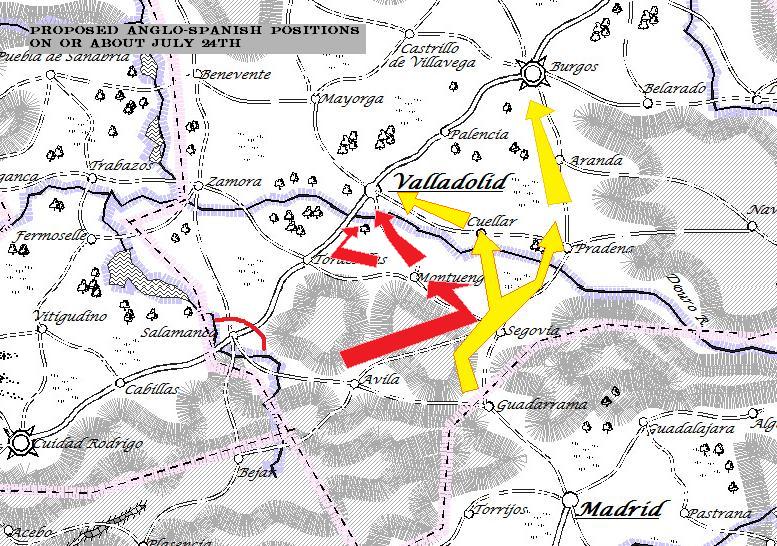
Napoleon though was not sitting idle. He too was looking for an opportunity to seize the initiative. His plan was to hold Valladolid with II Corps (they began to construct breastworks) while taking I and III Corps and marching for Madrid. The mustering point for this advance would be Segovia where III Corps was already waiting and the date that the attack would go forward was 24 July.
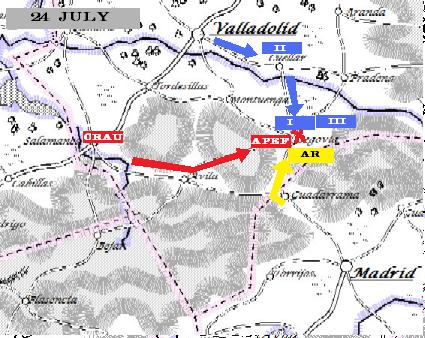
The second battle of Segovia was the result of two forces making offensive plans that unexpectedly clashed.
The result of the battle was that French III Corps and almost all of Castanos' Army Real was broken. Wellington too had suffered but I Corps under Marmont was remarkably fresh. Wellington and Castanos were surprised yet relieved when it was the French that withdrew in the night. It was a victory, but the cost was terrible and this is where a communication problem developed between Castanos and Wellington. The Spaniard ordered two strong divisions to pursue the French but told Wellington's staff that his army was in no condition to advance and it would be returning to Madrid to recover. Wellington apparently never got that information. For the next few days, he would be operating under the assumption that the original plan would be carried out. He immediately began marching his troops off west to hit Valladolid. Some were even force marched so that they were at the city the next evening. Spanish guerrillas were attacking Valladolid form the north as well.
The troops pursuing Napoleon encountered eleven combat divisions at Cuellar. The whole of the French army was massed there except for the II Corps headquarters that had remained behind at Valladolid to continue work with engineers on the breastworks. The Spanish pursuers quickly withdrew back to Segovia.
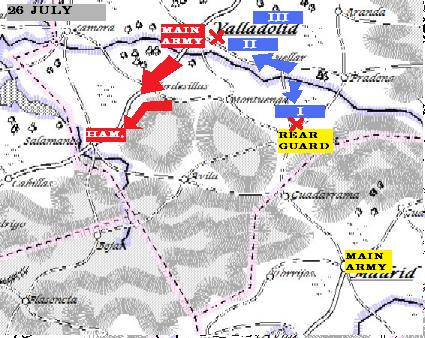
Napoleon was alarmed to find Valladolid under attack even while Spanish pursuit, however insignificant, was pushing against him at Cuellar. Instead of seeing it as a crisis though, it was an opportunity. He knew that the Spanish army was wrecked so the British on Valladolid must be operating alone. He proceeded to conduct a quick reorganization and moved all of his strongest divisions into I Corps and sent the remainder hurrying back to defend Valladolid. The earthworks built there would prove to be enough for even these exhausted divisions to hold back the British attack.
Wellington too though was doing reorganizing. Hamilton and a few battered divisions were sent back to Salamanca to recover while Crauford and a few divisions fresh up from the depot at Oporto, were sent forward with the main army to attack Valladolid.
The attack went poorly and the British were repulsed back to Tordesillas.
But while this fight was ongoing, Napoleon, with Marmont's corps, had re-crossed the Douro . The Spanish pursuit had become the rear guard and, under orders to avoid combat, these divisions would fall back under Napoleon's advance. Castanos was instantly made aware of this bold resumption of the offensive by Napoleon and messages were sent to Wellington to alert him of the situation. None of these couriers would find their way there through the direct route but would instead be obliged to ride wide to the west and would only reach APEF HQ three days later.
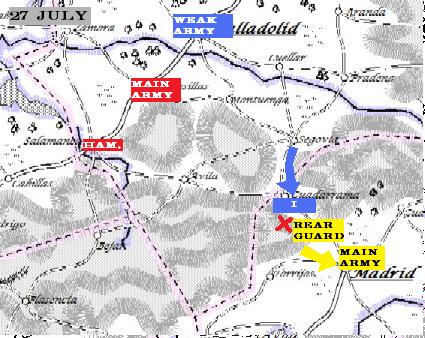
Wellington, completely in the dark as to Napoleon's presence on his flank, was still assuming that the Spanish were attacking toward Burgos. He was sending off messages though reporting his unexpected defeat at Valladolid. He would once again fall back toward Salamanca and rebuild his army to try another attack another day.
Madrid was in a panic as Napoleon marched toward the capital. Conscripts were hurriedly recruited and pushed into the divisions of the army. This would result in the overall lowering of the quality of Castanos' force. Castanos' Right Wing, 21,000 soldiers that had been caught in the siege of Valencia, were being marched at speed toward Madrid. The defenders of the city number some 40,000 and are increasing daily but Castanos will make a hard decision and the depot stores are destroyed or sent off in confiscated wagons toward the south. The depot would not be allowed to fall into French hands.
The Spanish Count paces nervously as the French near and many hours are spent wandering the battlefield that he already sees as his Zama.
He sends emissaries to Napoleon, offering peace for 6 months, including the removal of Portugal and Spain from the coalition with Britain. There is no response.
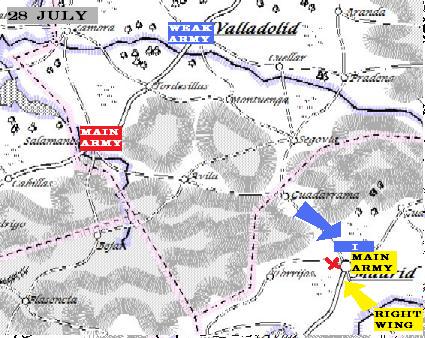 On July
28th, Marmont's army reaches Madrid and the two armies deploy for battle. The
headquarters from the Right Wing arrives and Castanos organizes his army into
three Corps.
On July
28th, Marmont's army reaches Madrid and the two armies deploy for battle. The
headquarters from the Right Wing arrives and Castanos organizes his army into
three Corps.
Napoleon had managed to split the Allied armies due to their lack of communication and divergent lines of operation. His manoeuvre was bold and not without risks. If Wellington had won at Valladolid he likely would have been obliged to abandon the attack and turn on the British. If one courier from Castanos had gotten through to Wellington to inform him of the French advance, 40,000 British soldiers might have been marching down the Guadarrama road behind Napoleon, cutting off any retreat route and, worse, hitting his army from the rear while his 40,000 French were engaged with 50,000 Spanish to their front.
This audacious campaign might have meant the complete destruction of Napoleon's Armee de Pyrenees but instead may give him the Spanish capital. At the very least, it has split the Allied armies and forced the Spanish to move their depot further back into Spain.